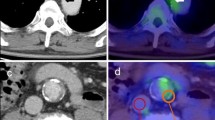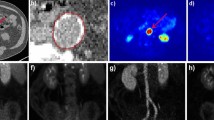Abstract
Background
We investigated long-term changes in aortic 18F-fluorodeoxyglucose (18F-FDG) uptake and calcification in health-screening subjects and their relation with atherogenic risk factors.
Methods and results
A total of 94 consecutive subjects (72 men, 22 women; age 47–85 years, mean 57.9 years) participating in a health-screening protocol were evaluated retrospectively. All subjects had follow-up PET/CT scans 3.0–5.8 years (mean 4.1 years) later. We measured 18F-FDG uptake (maximum SUV) and calcium score (Agatston score) of the ascending, descending thoracic and infrarenal abdominal aorta on PET/CT images. 18F-FDG uptake and calcium score of the whole aorta (FUWA and CSWA) increased significantly in the follow-up study compared with the initial study (p = 0.02 and p < 0.0001, respectively). Multiple regression analysis showed that the change in FUWA per year was significantly associated with visceral fat area, while the change of CSWA per year was significantly associated with age and smoking habit. The degrees of 18F-FDG uptake and calcium score increases were significantly greater in the abdominal aorta than in the thoracic aorta (p = 0.05 and p < 0.0001, respectively).
Conclusions
Our data demonstrated the longitudinal progressions of vascular inflammation and calcification of health-screening subjects. Inflammation and calcification were observed to progress significantly faster in the abdominal aorta than in the thoracic aorta. The progressions of vascular inflammation and calcification may be associated with different atherogenic risk factors.
Similar content being viewed by others
References
Chen W, Bural GG, Torigian DA, Rader DJ, Alavi A. Emerging role of FDG-PET/CT in assessing atherosclerosis in large arteries. Eur J Nucl Med Mol Imaging. 2009;36:144–51.
Rudd JH, Narula J, Strauss HW, Virmani R, Machac J, Klimas M, et al. Imaging atherosclerotic plaque inflammation by fluorodeoxyglucose with positron emission tomography: ready for prime time? J Am Coll Cardiol. 2010;55:2527–35.
Agatston A, Janowitz W, Hildner F, Zusmer N, Viamonte M Jr, Detrano R. Quantification of coronary artery calcium using ultrafast computed tomography. J Am Coll Cardiol. 1990;15(4):827–32.
Menezes LJ, Kotze CW, Hutton BF, Endozo R, Dickson JC, Cullum I, et al. Vascular inflammation imaging with 18F-FDG PET/CT: when to image? J Nucl Med. 2009;50:854–7.
Mehta NN, Torigian DA, Gelfand JM, Saboury B, Alavi A. Quantification of atherosclerotic plaque activity and vascular inflammation using [18F] fluorodeoxyglucose positron emission tomography/computed tomography (FDG-PET/CT). J Vis Exp. 2012;63:e3777.
Nakagawa K, Namba H, Iyo M, Fukushi K, Irie T, Yamanouchi M, et al. Simplified PET quantitation of myocardial glucose. J Nucl Med. 1995;36:2094–102.
Yoshida K, Endo M, Fukuda H, Kagaya A, Himi T, Masuda Y, et al. Measurement of arterial tracer concentrations from cardiac PET images. J Comput Assist Tomogr. 1995;19:182–7.
Adams MC, Turkington TG, Wilson JM, Wong TZ. A systematic review of the factors affecting accuracy of SUV measurements. AJR Am J Roentgenol. 2010;195(2):310–20.
Menezes LJ, Kayani I, Ben-Haim S, Hutton B, Ell PJ, Groves AM. What is the natural history of 18F-FDG uptake in arterial atheroma on PET/CT? Implications for imaging the vulnerable plaque. Atherosclerosis. 2010;211(1):136–40.
Mottillo S, Filion KB, Genest J, Joseph L, Pilote L, Poirier P, et al. The metabolic syndrome and cardiovascular risk: a systematic review and meta-analysis. J Am Coll Cardiol. 2010;56:1113–32.
Jayalath RW, Mangan SH, Golledge J. Aortic calcification. Eur J Vasc Endovasc Surg. 2005;30:476–88.
Rudd JH, Myers KS, Bansilal S, Machac J, Woodward M, Fuster V, et al. Relationships among regional arterial inflammation, calcification, risk factors, and biomarkers: a prospective fluorodeoxyglucose positron-emission tomography/computed tomography imaging study. Circ Cardiovasc Imaging. 2009;2:107–15.
Tahara N, Kai H, Yamagishi S, Mizoguchi M, Nakaura H, Ishibashi M, et al. Vascular inflammation evaluated by [18F]-fluorodeoxyglucose positron emission tomography is associated with the metabolic syndrome. J Am Coll Cardiol. 2007;49:1533–9.
Nishimura T, Nakajima K, Kusuoka H, Yamashina A, Nishimura S. Prognostic study of risk stratification among Japanese patients with ischemic heart disease using gated myocardial perfusion SPECT: J-ACCESS study. Eur J Nucl Med Mol Imaging. 2008;35:319–28.
Ministry of Health, Labour and Welfare of Japan. NIPPON DATA (National Integrated Project for Prospective Observation of Non-communicable Disease And its Trends in the Age performed in Nov., 2010) http://www.mhlw.go.jp/toukei/saikin/hw/kenkou/jyunkan/jyunkan00/gaiyo.html (in Japanese). Accessed 21 Mar 2012.
Tatsumi M, Cohade C, Nakamoto Y, Wahl RL. Fluorodeoxyglucose uptake in the aortic wall at PET/CT: possible finding for active atherosclerosis. Radiology. 2003;229:831–7.
Dunphy MPS, Freiman A, Larson SM, Strauss HW. Association of vascular 18F-FDG uptake with vascular calcification. J Nucl Med. 2005;46:1278–84.
Isselbacher EM. Thoracic and abdominal aortic aneurysms. Circulation. 2005;111:816–28.
Ku DN, Giddens DP, Zarins CK, Glagov S. Pulsatile flow and atherosclerosis in the human carotid bifurcation. Positive correlation between plaque location and low oscillating shear stress. Arteriosclerosis. 1985;5:293–302.
Davies PF. Flow-mediated endothelial mechanotransduction. Physiol Rev. 1995;75:519–60.
Police SB, Thatcher SE, Charnigo R, Daugherty A, Cassis LA. Obesity promotes inflammation in periaortic adipose tissue and angiotensin II-induced abdominal aortic aneurysm formation. Arterioscler Thromb Vasc Biol. 2009;29(10):1458–64.
Public Relations Office, Government of Japan. Taking Stock of the Ningen Dock, Highlighting Japan 2010. http://www.gov-online.go.jp/eng/publicity/book/hlj/html/201006/201006_04.html (in English). Accessed 7 Aug 2012.
Tahara N, Kai H, Ishibashi M, Nakaura H, Kaida H, Baba K, et al. Simvastatin attenuates plaque inflammation: evaluation by fluorodeoxyglucose positron emission tomography. J Am Coll Cardiol. 2006;48:1825–31.
Wu YW, Kao HL, Huang CL, Chen MF, Lin LY, Wang YC, et al. The effects of 3-month atorvastatin therapy on arterial inflammation, calcification, abdominal adipose tissue and circulating biomarkers. Eur J Nucl Med Mol Imaging. 2012;39(3):399–407.
Mizoguchi M, Tahara N, Tahara A, Nitta Y, Kodama N, Oba T, et al. Pioglitazone attenuates atherosclerotic plaque inflammation in patients with impaired glucose tolerance or diabetes a prospective, randomized, comparator-controlled study using serial FDG PET/CT imaging study of carotid artery and ascending aorta. JACC Cardiovasc Imaging. 2011;4(10):1110–8.
Lee SJ, On YK, Lee EJ, Choi JY, Kim BT, Lee KH. Reversal of vascular 18F-FDG uptake with plasma high-density lipoprotein elevation by atherogenic risk reduction. J Nucl Med. 2008;49:1277–82.
Acknowledgments
The authors would like to thank the staff of the PET Imaging Center and Health Screening Center at Asahi General Hospital for their skillful technical support. No potential conflicts of interest were disclosed.
Author information
Authors and Affiliations
Corresponding author
Rights and permissions
About this article
Cite this article
Ryu, Y., Yoshida, K., Suzuki, Y. et al. Long-term changes of aortic 18F-FDG uptake and calcification in health-screening subjects. Ann Nucl Med 27, 239–246 (2013). https://doi.org/10.1007/s12149-012-0679-z
Received:
Accepted:
Published:
Issue Date:
DOI: https://doi.org/10.1007/s12149-012-0679-z




